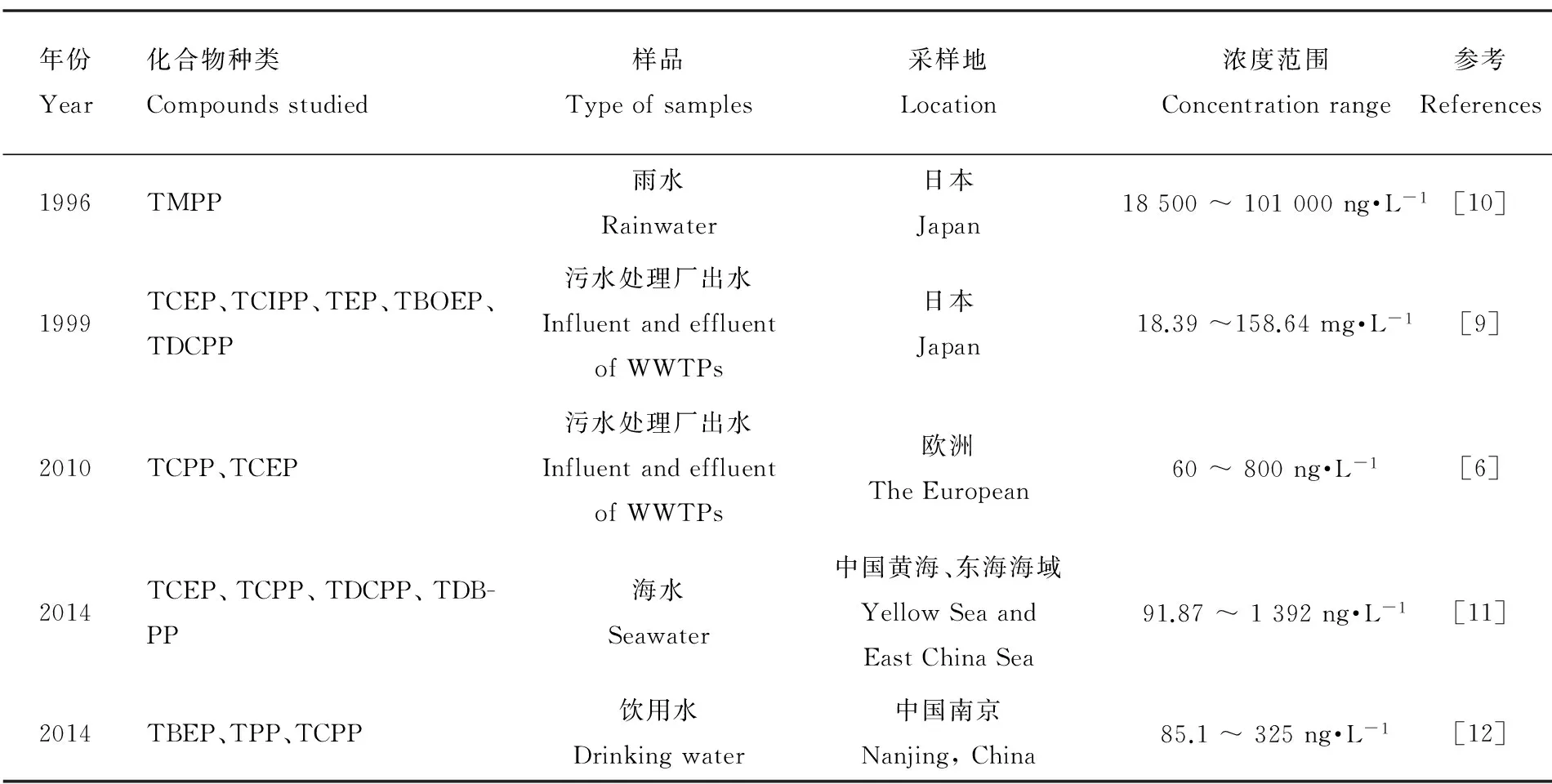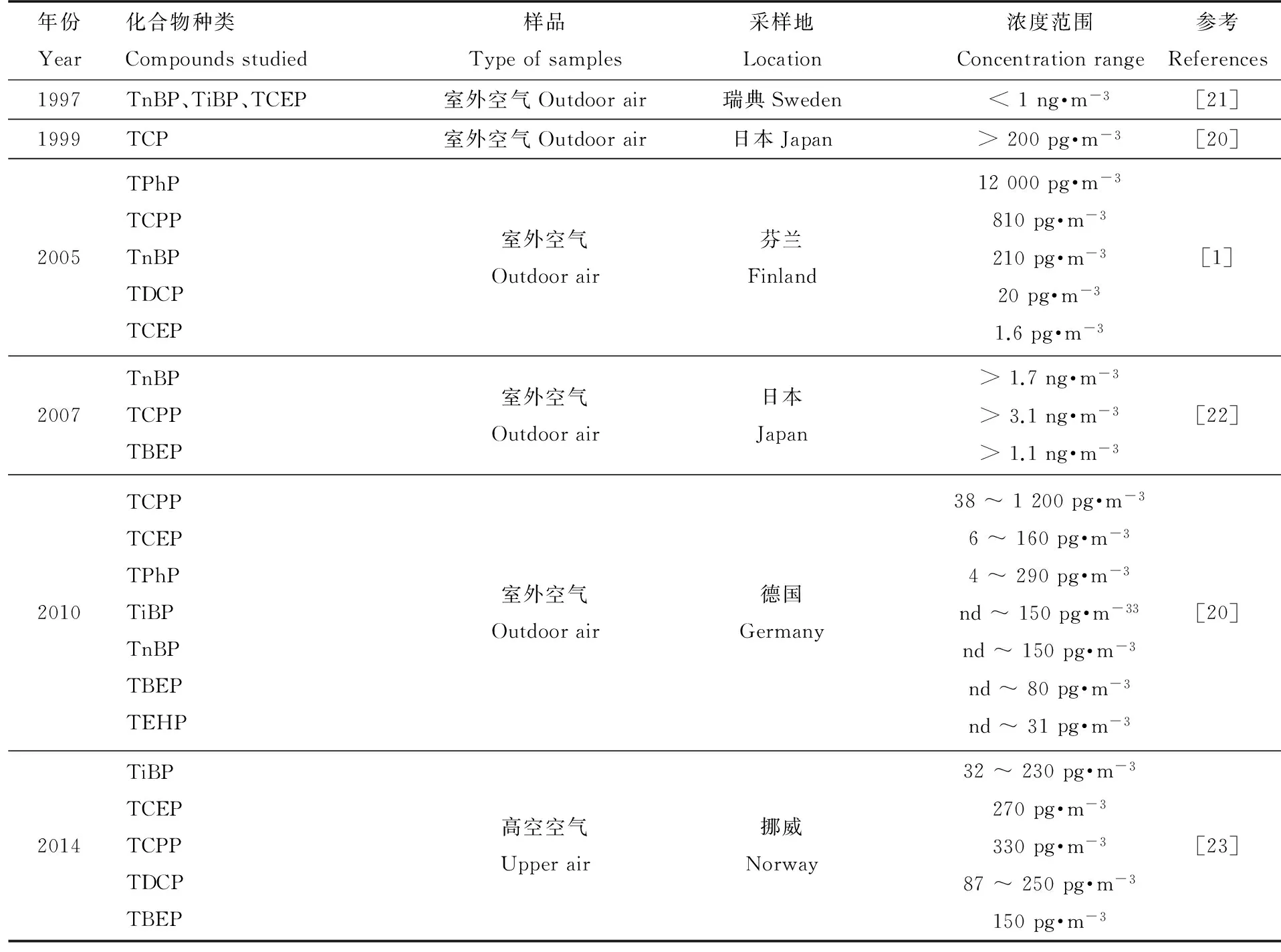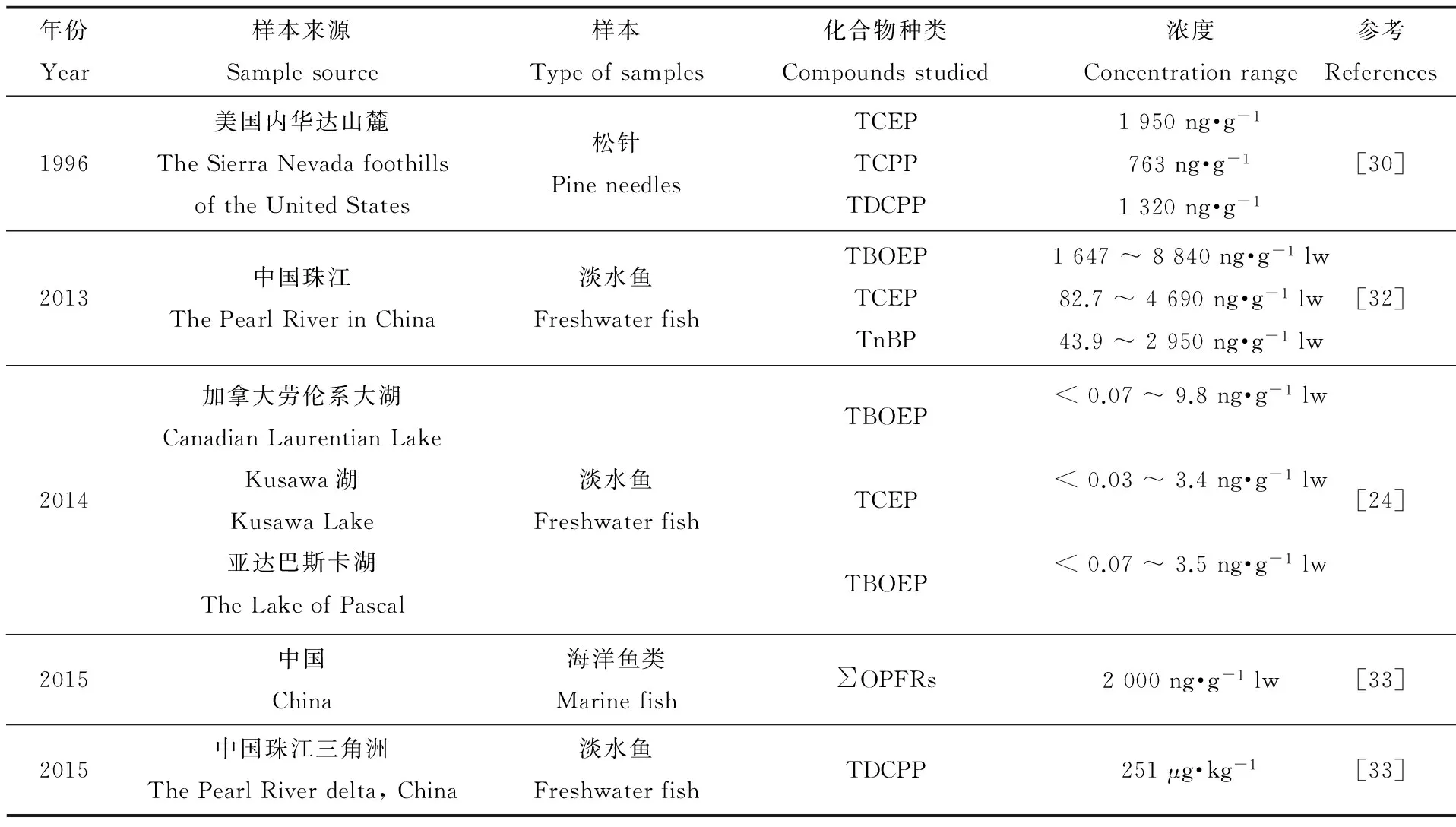有机磷系阻燃剂的全球污染现状
耿存珍,段玉双,王艺璇,胡飞,杨永亮,夏延致
1. 青岛大学环境科学与工程学院,青岛 266071 2. 青岛大学 海洋纤维新材料研究院 3. 青岛大学 山东省海洋生物质纤维材料及纺织品协同创新中心,青岛 266071 4 国家地质实验测试中心 国土资源部生态地球化学重点实验室,北京 100037
有机磷系阻燃剂的全球污染现状
耿存珍1,2,3,段玉双1,王艺璇1,胡飞1,杨永亮4,夏延致2,3,*
1. 青岛大学环境科学与工程学院,青岛 266071 2. 青岛大学 海洋纤维新材料研究院 3. 青岛大学 山东省海洋生物质纤维材料及纺织品协同创新中心,青岛 266071 4 国家地质实验测试中心 国土资源部生态地球化学重点实验室,北京 100037
作为目前普遍使用的阻燃剂主要种类之一,有机磷系阻燃剂被大量应用于各领域,从而导致了其在环境中的持续释放和分布,由此引发的环境问题逐步引起了人们的广泛关注。本文对全球范围内有机磷系阻燃剂在水体、大气、土壤、沉积物以及生物体内等环境介质中的残留现状进行了分析,并对其生态危害和生态风险进行了总结,同时对目前该领域仍有待探讨的问题及研究趋势进行了讨论。
有机磷系阻燃剂;全球范围;污染现状;生态风险
Received 9 November 2015 accepted 6 January 2016
由于全球范围内对溴系阻燃剂的生产及使用的限制,有机磷系阻燃剂(OPFRs)凭借其出色的阻燃效果被广泛应用于纺织、电子、家装材料、交通运输等行业,产量和使用量迅速提高。据不完全统计,2001年,全球有机磷类物质(OPs,其中70%为OPFRs)用量总计186 000 t[1],2004年达300 000 t[2];在西欧,OPs的用量从1998年的58 000 t增长到2001年的83 000 t,2005年时达到了85 000 t,再到2006年的91 000 t[3-4];在日本,OPs用量在2001年达22 000 t,2005年达30 000 t[2,5];在中国,OPs 2007年的年产量接近70 000 t,且预计每年将增加15%[6]。其中,有机磷酸酯类阻燃剂(OPEs)目前使用最为普遍,被广泛应用于聚氯乙烯、聚苯乙烯、聚氨酯、橡胶和涂料产品中。由于OPFRs主要以添加方式而非化学键合方式加入到材料中,且大多数具有半挥发性,因此很容易通过挥发、产品磨损和渗漏等方式进入到各种环境介质中造成污染[7]。目前,OPFRs已普遍存在于大气、水体、土壤和生物体内。其中,OPEs具有致癌性、神经毒性和生殖毒性,氯代磷酸酯阻燃剂已被欧盟列为高度关注物质[8]。
1 OPFRs在环境中的残留(Environmental residual of OPFRs)
1.1 水体
近年来国内外的学者[9-12]对部分国家和地区水体中的OPFRs的残留状况做了研究调查,将不同地区各类水体中OPFRs的污染状况总结,见表1。
对日本临海固废处理站的未处理废水进行取样检测,结果显示,最高浓度水平的OPs为TCEP,浓度为4.23 ~ 87.4 mg·L-1,其次为TCIPP,浓度为11.3 ~ 48.2 mg·L-1,另外,TEP浓度为1.33 ~ 10.6 mg·L-1,TBOEP为0.85 ~ 6.26 mg·L-1,TDCPP为0.68 ~ 6.18 mg·L-1[9]。对日本温室附近的降水进行取样检测发现,样品中浓度最高的OPs是TMPP,中值为6 100 ng·L-1[10]。由表中可以看出,日本污水处理厂出水以及雨水中的OPFRs浓度极高,可以推测日本在90年代时OPFRs的使用量极大,这可能与各行业的发展壮大有关,且可推测雨水中的OPFRs来源于大气颗粒物。
由于欧盟禁用溴代阻燃剂,并采用OPEs作为主要替代品,因此在欧洲多国污水处理厂(WWTPs)的污水中均可检出OPEs。一项针对欧洲各国污水处理厂水质情况的调查显示,大多数污水处理厂的出水中可以检出磷酸三氯丙酯(TCPP)和磷酸三(2-氯)乙酯(TCEP),其浓度维持在几百个ng·L-1,并且TCPP具有难降解的特性[6]。

表1 水环境中OPFRs污染现状
注:TMPP、TCEP、TCIPP、TEP、TBOEP、TDCPP、TCPP、TDBPP、TBEP、TPP分别为正亚磷酸三羟甲基丙烷、磷酸三(2-氯乙基)酯、磷酸三(2-氯丙基)、磷酸三乙酯、三(2-丁氧基乙基)磷酸酯、磷酸三(1,3-二氯-2-丙基)酯、磷酸三(1-氯-2-丙基)酯、磷酸三(2,3-二溴丙基)酯、磷酸三(丁氧基乙基)酯、磷酸三苯酯。
Note: TMPP, TCEP, TCIPP, TEP, TBOEP, TDCPP, TCPP, TDBPP, TBEP, TPP stand for tricresyl phosphate, tri (2-chloroethyl) phosphate, tris(2-chloroisopropyl) phosphate, triethyl phosphate, tributoxyethyl-phosphate,tdcpp tris(1,3-dichloro-2-propyl) phosphate, tri (chloropropyl) phosphate, tris(2,3-dibromopropyl)phosphate, tris-(2-butoxyethyl)phosphate, tripropyl phosphate.
由此可以看出,日本及欧洲等发达国家和地区的污水处理厂出水中的OPFRs并未被完全去除,说明现有的污水处理工艺并不完善,不能较好的去除水中的OPFRs,需要改进和提高。
对中国青岛、连云港、厦门附近的黄海、东海海域的海水样本进行检测后发现,TCEP、TCPP、TDCPP、TDBPP都被检出,且4种物质浓度的平均值分别为134.44 ng·L-1、84.12 ng·L-1、109.28 ng·L-1、96.70 ng·L-1。通过检测数据可以看出,检出物中TCEP浓度最高,TDCPP和TDBPP也有较高的浓度。调查同时表明,连云港是OPFRs污染最严重的区域,检测发现此处TCEP的浓度为550.54 ~ 617.92 ng·L-1[11]。在另一项研究中,中国南京6家水处理厂处理过后的水样检测发现,TBEP、TPP、TCPP是检出频率、浓度都很高的3类OPFRs,其浓度分别为70.1 ng·L-1、40.0 ng·L-1和33.4 ng·L-1;同时他们发现瓶装水中也同样存在OPFRs,只是浓度较自来水低了10%~ 25%[12]。因此,由南京饮用水中含有85.1 ~ 325 ng·L-1的OPFRs,也反映出中国现有的水净化工艺不能完全去除水中的OPFRs。

表2 室内空气环境中OPFRs的污染现状
注:MDL代表方法检出限。TPhP、TiBP、TnBP为磷酸三苯酯、磷酸三异丁酯、磷酸三正丁酯。
Note: MDL stands for method detection limit. TPhP, TiBP, TnBP stand for triphenyl phosphate, triisobutyl phosphate, tri-n-butyl phosphate.
1.2 大气
1.2.1 室内空气
由于OPFRs被广泛应用于建材、纺织、化工以及电子等行业,导致家具、地毯、墙纸、装饰材料及电视机等都会残留一定量的阻燃剂作为污染的室内来源。欧洲及亚洲许多国家的室内空气和空气颗粒物中都检测出了OPFRs。
比较总结近年来的有关室内空气环境中OPFRs的残留状况,见表2。瑞士苏黎世室内空气样品中的TPhP残留在0.19 ~ 5.7 ng·m-3之间[13]。通过对比利时弗兰德斯地域室内空气颗粒物样品的检测发现[14],TiBP、TBEP和TCPP含量最多,在住所空气颗粒物样品中分别为2.99 μg·g-1、2.03 μg·g-1和1.38 μg·g-1,在商店的空气颗粒物样品中分别为1.04 μg·g-1、3.61 μg·g-1和2.94 μg·g-1,OPFRs总量的中值为16.5 μg·g-1。另外,在一家木工制作车间空气颗粒物的样品中,检测出的TCPP、TPP和TCP的含量分别为24.4 μg·g-1、34.2 μg·g-1、12.5 μg·g-1。调查研究表明,TCEP在二手商店中含量高达5.46 μg·g-1。对西班牙室内空气颗粒物样品的研究发现[15],TnBP、TPP、TCPP和TDCPP的含量与比利时基本相似,TiBP含量较比利时较低,均值在0.21 μg·g-1,而TCEP、TBEP含量较高。Marklund等[1]发现,部分采样点的天花板中TCEP含量达68 g·kg-1,床垫中TCPP含量达180 g·kg-1。2011年11月到2012年5月,对德国日托中心的空气样品进行检测发现[6],TBEP、TCPP和TnBP含量最多;TCEP、TBEP、DPEHP检出率为100%,其含量中值分别为0.40 mg·kg-1,225 mg·kg-1,1.1 mg·kg-1;TCPP检出率为94%;TPhP浓度约为0.5 mg·kg-1。Staaf和Ostman[16]对瑞士的一间电子设备拆卸车间的空气进行检测发现,9种OPEs被检出,其中,TPhP浓度为17 ng·m-3,TCEP浓度为10 ng·m-3。Fan等[17]对加拿大的室内空气样品进行检测,结果显示,浓度最高的是TBEP,TDCPP浓度次之,TPhP浓度排第三位,但检出率为100%。另外,在对新西兰室内空气的研究发现[18],TBEP同样也是浓度最高的OPFR,其次是TPhP,TCPP居第三位。对美国的同类研究发现[19],在7种被检物质中,除TPhP、TDCPP和TCPP外,其他4种都低于检测限。

表3 室外空气环境中OPFRs的污染现状
注: nd代表未检出。TDCP、TBEP、TEHP为磷酸二氯丙酯、邻苯二甲酸二(2-丁氧基)乙酯、磷酸三(2-乙基己基)酯。
Note: nd stands for under detection limitation. TDCP, TBEP, TEHP stand for tris-(1,3-dichloro-2-propyl)phosphate, tris-(2-butoxyethyl)phosphate, tris(2-ethylhexyl) phosphate.
由表中数据可以看出,OPFRs在上述区域都有分布。同一种物质在不同国家的浓度也不尽相同,这可能与国家的产业结构及其发展等因素有关。2004和2005年,在瑞士,TPhP的室内含量在电子拆卸车间明显比其他地点高出许多,恰恰验证了OPFRs出现频率越高、使用量越大的环境,其OPFRs的残留量也越大的特点。
1.2.2 室外空气
1997年Carlsson等[20]发现,瑞典的靠近建筑物的空气中TnBP、TiBP、TCEP、TCPP、TPhP、TBEP和TEHP的浓度都很低,但检出率为100%;1999年日本学者Takimoto等[21]就对Kurose河盆地的空气进行了研究,发现TCP的含量大于200 pg·m-3。2010年Möller等[22]对北海的德国境内采集的空气样本进行OPs检测,结果显示,8种被检物质中TCPP含量居于首位,约占总量的60.16%,比TCEP高出许多;8种物质的检出率为20%~100%;OPs的总浓度为110~1 400 pg·m-3。另外,2007年Saito等[23]调查发现日本居所及办公楼外的空气中都检测到了TnBP、TCPP和TBEP。据2005年Marklund等[1]报道,在芬兰北部偏远地区的空气中也检出了TPhP、TCPP、TnBP、TDCP和TCEP。在对北极挪威的新型污染物进行筛查的过程中发现了高空空气中残留的TiBP、TCEP、TCPP、TDCP和TBEP[24]。对室外空气环境中OPFRs的污染状况调查数据总结,见表3。
由表中数据可以看出,OPFRs在欧洲、亚洲甚至在北极都有残留,并且其浓度都在pg·m-3~ng·m-3的数量级,许多种类的OPFRs在室外空气中都可以被检出,并且,不论是在城市街道,还是在郊区和偏远地区,人们已经在空气中的悬浮微粒样品和灰尘样本中均发现了OPFRs的残留,反映了OPFRs的存在范围之广。
1.3 土壤及沉积物
研究表明[25-29],不同地区的土壤中残留着不同浓度的有机磷污染。部分地区土壤及沉积物中OPFRs的残留状况,见表4。

表4 部分地区土壤及沉积物中OPFRs的污染现状
注:TBP、EHDPP、TCrP、TPPO为磷酸三丁酯、磷酸(2-乙基)己基二苯酯、磷酸三甲苯酯、三苯基氧化磷。Note: TBP, EHDPP, TCrP, TPPO, EHDP stand for tributyl phosphate, 2-ethylhexyl diphenyl phosphate, tricresyl phosphate, triphenyl phosphine oxide.
分析结果表明,在日本温室附近采集的土样中,TMPP含量居多;美国空军基地的土样中TPHP含量居多;在德国Osnabrueck大学校园采集的土样中TCIPP、TPHP和TCEP都有不同程度的残留。广州市城区表层土壤中TEP、TBP、TBEP、EHDPP、TEHP、TCEP、TCPP、TPhP、TCrP、TPPO普遍检出,非卤代磷酸酯污染水平高于氯代磷酸酯,TBEP、TCrP为主要OPEs。
沉积物中有机磷的污染也是不容忽视的。挪威、瑞典、西班牙和德国的海洋沉积物样品中检测出了大量的有机磷,其中以TCIPP、TBOEP、EHDPP和TBP居多。固体废物海洋填埋场沉积物中检测到较高浓度的OPEs,TCEP和TBEP是沉积物中检出的主要化合物,并且在水体中未检出的TEHP在沉积物中也有较高浓度的残留。在西班牙境内的阿尔加河、纳尔河和贝索斯河的沉积物样品中检测出了TEHP、EHDP、TCP、TPhP、TCPP、TBP、TiBP、TDCP和TCEP。我国台湾地区河水和海水沉积物中也有OPEs的残留。
1.4 生物
通过对某些生物体的检测,在其体内发现了OPFRs的存在。在珀尔湖环境的研究发现水体中有大量的OPFRs残留,在湖中鱼的体内也同样发现了OPFRs的踪迹,尤其是TBOEP、TCEP、TNBP、TCEP和TNEP的残留显著。同样在斑马鱼、大型水蚤、贝类、各种鸟类以及松针里也都检测到了有机磷类物质的存在。
对于不同生物体内OPFRs残留状况的调查,见表5。Aston等[30]于1996年在美国内华达山麓的松针中检测出了TCEP、TCPP和TDCPP的存在。Letcher等[31]在五大湖区的银鸥蛋中检测到了TBOEP和TPHP,浓度分别为nd ~ 39 ng·g-1lw,2.1 ~ 8.2 ng·g-1lw。Ma等[32]发现,中国珠江的鱼体内含有极高浓度的OPs。McGoldrick等[24]在加拿大各湖泊中的淡水鱼体内检测到的6种OPFRs为TCEP、TCIPP、TDCIPP、TPHP、TBP、TBOEP;TCEP和TBOEP是湖红点鲑体内最集中、检出最频繁的物质;在劳伦系大湖中,TBOEP在65%的湖红点鲑体内检出;大熊湖、Kusawa湖、亚达巴斯卡湖的水生鱼类体内TCEP和TBOEP都在较低浓度水平,其中TCEP在75%的湖红点鲑体内检出;TBOEP在67%的湖红点鲑体内检出。另外,2015年,Wang等[33]在中国南方珠江三角洲区域的淡水鱼肌肉样品中检测的TDCPP浓度达到了251 μg·kg-1。从这些研究中不难发现,当前的生物体内已经残留了不同程度的OPFRs。

表5 部分生物体内各OPFRs的残留
注:nd——未检出。
Note: nd stands for under detection limitation.
从表中可以看出,中国珠江流域的淡水鱼体内OPFRs的浓度2013年到2015年在数量级上没有明显变化。而对淡水鱼体内TBOEP的浓度进行比较,可以看出,中国珠江流域的淡水鱼体内的浓度比加拿大劳伦系大湖中的高出许多。鉴于美国内华达山脉的松针里检测出TCEP、TCPP的浓度,可以推测当地大气环境中有该类物质的存在。
1.5 人体
Fromme等[34]已经在德国人的尿液样品中检出了OPEs的代谢物,说明人体内存在OPEs,在312名年龄在22到80个月,体重从10到34 kg的儿童提供的尿液样品中发现TPhP、TBEP、TnBP、TCEP和TCPP都有不同程度的检出;男性的DBEP代谢物浓度比女性更高一些(中值:女1.5 μg·L-1,男2.4 μg·L-1);对3组不同年龄段的参加者进行检测发现最年轻的一组DBEP代谢物的浓度最高(中值分别为3.4 μg·L-1、1.7 μg·L-1、1.9 μg·L-1)。
Schindler等[35]检测了30个成年德国人的尿液样本,结果显示,DPhP处于一个相对较高的浓度水平,为0.5 μg·L-1(<0.3~5.5 μg·L-1)。在另一项研究中,Mach[36]对42个成年德国人的尿液样品进行检测,DBEP、TPhP及其他代谢物DnBP、DCEP都有不同程度的检出。对于这些研究结果具体数据见表6。
另外,Sundkvist等[37]从瑞典收集的人乳中检测出了OPEs的存在,浓度为46.0~180 ng·g-1lw,其中TCIPP和TNBP是检出率最高的2类OPEs。
OPFRs在环境中残留量的增多使其进入人体的途径随之增多,由此带来的对人体健康的潜在威胁不容忽视。虽然目前有关人体内OPFRs的来源尚无明确定论,但研究学者普遍认为除食物和水的摄入及吸入含OPFRs的气溶胶外,OPFRs还可以通过表皮的吸附、吸收进入人体[38-40]。因此,对于OPFRs在人体中的残留还需要再深入研究,比如可以检测人体的其他组织或器官中的含量以确定OPFRs在人体中的积累及蓄积状况,更好的了解OPFRs对人类健康的影响,这有待于进一步的深入研究。
2 生态风险(Ecological risk)
OPEs在水体中的残留会增加水体中磷元素的含量,进而加重水体的富营养化,对水体造成严重影响;另外水体中的OPEs还会使各类水生生物体内的OPEs含量增多,这不仅会对鱼类及其他水生生物造成危害,更会通过食物链进一步的加重在人体中的残留并造成危害;生活用水或饮用水中的OPEs,能直接进入人体,对人体造成危害。OPEs在空气中的残留会使其通过直接接触和呼吸作用进入生物体和人体,造成毒害作用。OPEs在土壤和沉积物中的残留使得生活在其中的动物植物体内农作物植株里的OPEs含量增多,也可能危及到人类健康。

表6 人体尿液样品中OPEs的残留
注:DBEP、DPhP、DnBP、DCPP、DCEP、DmCP、DpCP分别为邻苯二甲酸二(2-丁氧基)乙酯、邻苯二甲酸二(2-丙基庚)酯、邻仲丁基-4,6二硝基苯酚、双(六氯环戊二烯)环辛烷、双(2-氯乙基)磷酸酯、二甲基环丙烯、二苯基磷酰氯。
Note: DBEP, DPhP, DnBP, DCPP, DCEP, DmCP, DpCP stand for di-(2-butoxyethyl) phosphate, diphenylphosphate, di-n-butyl phosphate, di-(2-chloroisopropyl) phosphate, di-(2-chloroethyl) phosphate, di-m-cresyl phosphate, di-p-cresyl phosphate.
毒理学研究表明暴露的有机磷系阻燃剂对动物以及人体的神经系统、生殖系统、内分泌系统乃至全身都有不利影响。不同有机磷类物质的毒物学特征是不一样的。动物实验表明:TCEP、TPhP和TCP主要显示神经的毒害作用;TDCP和TBEP影响肾脏和肝脏;TnBP表现在对膀胱的影响。TCEP对神经系统的毒性以及它与TDCPP的潜在致癌效应使其受到关注。Wang等[33]调查了长期暴露于TDCPP对斑马鱼神经系统的影响,结果显示,TDCPP浓缩量在成年鱼的组织内(包括大脑)是可以测量的,雌性鱼体内的含量高于雄性,雌性对TDCPP的神经致毒性更为敏感。结果同时证明了长期暴露在低浓度水平的TDCPP下也会导致神经系统中毒。TPP和TCP由于它们对土地的生产力存在的可能不利影响也同样受到关注[14]。Liu等[41]通过对斑马鱼及人类H295R细胞系(H295R细胞可以控制性激素的合成以及合成类固醇的基因转录)的调查研究发现,OPFRs可以通过包括改变类固醇的生成及改变雌性激素在内的几种机制改变性激素的平衡。虽然TCEP、TDCPP和TnBP尚未被国际机构列为致癌物质,但有迹象表明这些物质存在动物致癌潜力[34]。最新的研究已经开始关注环境中OPEs对人体的影响,已有文献表明室内灰尘中的TDCP和TPhP可抑制人体荷尔蒙水平,并严重降低男性精液质量[10]。
3 总结(Summary)
有机磷系阻燃剂作为阻燃行业的使用大户,随着经济的发展,其使用量与日俱增,在环境中残留量也随之增多,由此带来的对人体健康的潜在威胁已经不容忽视。
本文通过对大气、水、土壤、沉积物,人体及部分生物等环境介质中有机磷系阻燃剂的残留进行了详细的调查研究,发现许多国家和地区(包括欧洲的许多国家、日本、中国)的水体中都检测出了OPFRs,且含量较高;比利时、德国、瑞士、中国、日本等许多国家的室内空气中也存在着一定程度的OPFRs的残留;日本、芬兰、德国的大气中检测出了低浓度OPFRs的存在,但检出率偏高;日本、美国、中国、挪威、瑞典、西班牙和德国的土壤及沉积物中检测出大量OPFRs的残留,甚至德国人的尿液样品及血液中都检测到了OPFRs代谢物的存在。
由此可见,OPFRs的残留污染已经演变为全球污染问题,目前的研究还只是处于刚刚起步,各方面的环境数据还不够完善,需要对其进行更加深入和更广泛地开展基础调查,为有机磷系阻燃剂的污染控制研究提供数据,搞清它们在环境中的迁移和转化规律,以及部分OPFRs(如OPEs)的致癌性等其他环境毒理学性质和参数,从而对OPFRs进行合理的安全性评价,以便于引起世界广泛关注,同时加快更加环境友好型阻燃剂的研发步伐。
[1] Marklund A, Andersson B, Haglund P. Organophosphorus flame retardants and plasticizers in air from various indoor environments [J]. Journal of Environmental Monitoring, 2005(7): 814-819
[2] Moller A, Sturm R, Xie Z Y, et al. Organophosphorus flame retardants and plasticizers in airborne particles over the Northern Pacific and Indian Ocean toward the polar regions: Evidence for global occurrence [J]. Environmental Science & Technology, 2012, 46(6): 3127-3134
[3] European Flame Retardant Association.(2014-08-28). http://www.cefic-efra.com/
[4] European Union (EU). Tris[2-chloro-1-(chloromethyl)ethyl] Phosphate (TDCP) CAS No.: 13674-87-8. EINECS No.: 237-159-2, Risk Assessment Report [R]. 2008
[5] Japan Chemical Daily. Kagakukogyo Nenkan (The Annu. Chem. Tnd.). (2014-06-30). http:// www. chemicaldaily.co.jp/
[6] 王晓伟, 刘景富, 阴永光. 有机磷酸酯阻燃剂污染现状与研究进展[J]. 化学进展, 2010, 22(10): 1983-1992
Wang X W, Liu J F, Yin Y G. The pollution status and research progress on organophosphate ester flame retardants [J]. Progress in Chemistry, 2010, 22(10): 1983- 1992 (in Chinese)
[7] 严小菊, 何欢, 彭英, 等. 固相萃取一气相色谱质谱法检测水体中典型有机磷酸酯阻燃剂[J]. 分析化学研究报告, 2012, 40(11): 1693-1697
Yan X J, He H, Peng Y, et al. Determination of organophosphorus flame retardants in surface water by solid phased extraction coupled with gas chromatography-mass spectrometry [J]. Chinese Journal of Analytical Chemistry, 2012, 40(11): 1693-1697 (in Chinese)
[8] 林亚英, 陈弘丽, 曹美苑, 等. 城市市政污水A2O处理过程中有机磷酸酯阻燃剂的行为研究[C]. 第六届全国环境化学大会 水环境化学, 上海, 2011
Lin Y Y, Chen H L, Cao M Y, et al. Research on behavior of organic phosphate flame retardants in the A2O process of municipal sewage [R]. The 6th National Conference on Environmental Chemistry. Water Environment Chemistry, Shanghai, 2011 (in Chinese)
[9] Kawagoshi Y, Nakamura S, Fukunaga I. Degradation of organophosphoric esters in leachate from a sea-based solid waste disposal site [J]. Chemosphere, 2002, 48(2): 219 -225
[10] Cho K J, Hirakawa T, Mukai T, et al. Origin and storm water runoff of TCP (tricresyl phosphate) isomers [J]. Water Research, 1996, 30(6): 1431-1438
[11] Hu M Y, Li J, Zhang B B, et al. Regional distribution of halogenated organophosphate flame retardants in seawater samples from three coastal cities in China [J]. Marine Pollution Bulletin, 2014, 86(1-2): 569-574
[12] Li J, Yu N Y, Zhang B B, et al. Occurrence of organophosphate flame retardants in drinking water from China [J]. Water Research, 2014, 54: 53-61
[13] Hartmann P C, Burgi D, Giger W. Organophosphate flame retardants and plasticizers in indoor air [J]. Chemosphere, 2004, 57(8): 781-787
[14] Van den Eede N, Dirtu A C, Neels H, et al. Analytical developments and preliminary assessment of human exposure to organophosphate flame retardants from indoor dust [J]. Environment International, 2011, 37(2): 454-461
[15] García M, Rodríguez I, Cela R. Microwave-assisted extraction of organophosphate flame retardants and plasticizers from indoor dust samples [J]. Chromatography A, 2007, 590(17): 1152-1158
[16] Staaf T, Ostman C. Indoor air sampling of organophosphate trimesters using solid phase extraction (SPE) adsorbents [J]. Journal of Environmental Monitoring, 2005(4): 344-348
[17] Fan X H, Kubwabo C, Rasmussen P E, et al. Simultaneous determination of thirteen organophosphate esters in settled indoor house dust and a comparison between two sampling techniques [J]. Science of the Total Environment, 2014, s491- 492: 80-86
[18] Ali N, Dirtu A C, Van den Eede N, et al. Occurrence of alternative flame retardants in indoor dust from New Zealand: Indoor sources and human exposure assessment [J]. Chemosphere, 2012, 88(11): 1276-1282
[19] Stapleton H M, Klosterhaus S, Eagle S, et al. Detection of organophosphate flame retardants in furniture foam and US house dust [J]. Environmental Science & Technology, 2009, 43: 7490 -7495
[20] Carlsson H, Nilsson U, Becker G, et al. Organophosphate ester flame retardants and plasticizers in the indoor environment analytical methodology and occurrence [J]. Environmental Science and Technology, 1997, 31(10): 2931-2936
[21] Takimoto K, Hirakawa T, Ito K, et al. Source and transport of tricresyl phosphate (TCP) isomers in Kurose river basin [J]. Atmospheric Environment, 1999, 33(33): 3191-3200
[22] Möller A, Xie Z Y, Caba A, et al. Organophosphorus flame retardants and plasticizers in the atmosphere of the North Sea [J]. Environmental Pollution, 2011, 159(12): 3660 -3665
[23] Saito I, Onuki A, Seto H. Indoor organophosphate and polybrominated flame retardants in Tokyo [J]. Indoor Air, 2007, 17(1): 28-36
[24] McGoldrick D J, Letcher R J, Barresi E, et al. Organophosphate flame retardants and organosiloxanes in predatory freshwater fish from locations across Canada [J]. Environmental Pollution, 2014, 193: 254-261
[25] Chung H W, Ding W H. Determination of organophosphate flame retardants in sediments by microwave-assisted extraction and gas chromatography-mass spectrometry with electron impact and chemical ionization [J]. Analytical and Bioanalytical Chemistry, 2009, 395(7): 2325-2334
[26] 刘敬勇, 孙水裕, 许燕滨, 等. 广州城市污泥中重金属的存在特征及其农用生态风险评价[J]. 环境科学学报, 2009, 29(12): 2545-2556
Liu J Y, Sun S Y, Xu Y B, et al. Heavy metal characteristics in sewage sludge and its potential ecological risk assessment for agriculture use in Guangzhou [J]. Acta Scientiae Circumstantiae, 2009, 29(12): 2545-2556 (in Chinese)
[27] 温家欣. 有机磷酸酯阻燃剂的分离分析技术及其应用研究[D]. 广州: 中山大学, 2010
Wen J X. Study and application of separation and analysis of organophosphorus trimesters [D]. Guangzhou: Zhongshan University, 2010 (in Chinese)
[29] Cristale J, Vázquez A G, Barata C, et al. Priority and emerging flame retardants in rivers: Occurrence in water and sediment, Daphnia magna toxicity and risk assessment [J]. Environment International, 2013, 59: 232-243
[30] Aston L S, Noda J, Seiber J N, et al. Organophosphate flame retardants in needles of Pinus ponderosa in the Sierra Nevada foothills [J]. Bulletin of Environmental Contamination and Toxicology, 1996, 57(6): 859-866
[31] Letcher R J, Chen D, Chu S G, et al. Organophosphate triester flame retardant and phosphoric acid diester metabolite analysis and spatial and temporal trends in herring gulls from the North American Great Lakes [J]. Organohalogen Compounds, 2011, 73: 1257-1260
[32] Ma Y Q, Cui K Y, Zeng F, et al. Microwave-assisted extraction combined with gel permeation chromatography and silica gel cleanup followed by gas chromatography-mass spectrometry for the determination of organophosphorus flame retardants and plasticizers in biological samples [J]. Analytica Chimica Acta, 2013, 786: 47-53
[33] Wang Q W, Lam J C W, Man Y C, et al. Bioconcentration, metabolism and neurotoxicity of the organophorous flame retardant 1,3-dichloro 2-propyl phosphate (TDCPP) to zebrafish [J]. Aquatic Toxicology, 2015, 158: 108-115
[34] Fromme H, Lahrz T, Kraft M, et al. Organophosphate flame retardants and plasticizers in the air and dust in German daycare centers and human biomonitoring in visiting children (LUPE 3) [J].Environment International, 2014, 71: 158-163
[35] Schindler B K, Förster K, Angerer J. Determination of human urinary organophosphate flame retardant metabolites by solid-extraction and gas chromatography-tandem mass spectrometry [J]. Chromatography B, 2009, 877(4): 375-381
[36] Mach C. Development and application of analytical methods for human biomonitoring of flame retardants composed of organophosphate triesters (in German) [D]. Erlangen, Germany: University of Erlangen-Nuremberg, 2014
[37] Sundkvist A M, Olofsson U, Haglund P. Organophosphorus flame retardants and plasticizers in marine and fresh water biota and in human milk [J]. Journal of Environmental Monitoring, 2010(7): 943-951
[38] Makinen M S E, Makinen M R A, Koistinen J T B, et al. Respiratory and dermal exposure to organophosphorus flame retardants and tetrabromobisphenol A at five work environments [J]. Environmental Science & Technology, 2009, 43(3): 941-947
[39] Hughes M F, Edwards B C, Mitchell C T, et al. In vitro dermal absorption of flame retardant chemicals [J]. Food and Chemical Toxicology, 2001, 39(12): 1263-1270
[40] Meeker J D, Hu H, Cantonwine D E, et al. Urinary phthalate metabolites in relation to preterm birth in Mexico City [J]. Environmental Health Perspectives, 2009, 117(10): 1587-1592
[41] Liu X S, Ji K, Choi K. Endocrine disruption potentials of organophosphate flame retardants and related mechanisms in H295R and MVLN cell lines and in zebra fish [J]. Aquatic Toxicology, 2012, 114-115: 173-181
◆
Pollution Status on Organophosphorus Flame Retardants at the Global Scale
Geng Cunzhen1,2,3, Duan Yushuang1, Wang Yixuan1, Hu Fei1, Yang Yongliang4, Xia Yanzhi2,3,*
1. College of Environmental Science and Engineering, Qingdao University, Qingdao 266071, China 2. Institute of Marine Biobased Materials, Qingdao University, Qingdao 266071, China3. Co-Innovation Center for Marine Biomass Fibers, Materials and Textiles of Shandong Province, Qingdao University, Qingdao 266071, China 4. National Research Center of Geoanalysis, Key Laboratory of Ecological Geochemistry, MLR, Beijing 100037, China
As one of the most commonly used flame retardants, organophosphorus flame retardants (OPFRs) are widely applied in many fields, which results in continuous release and ubiquitous distribution in different environmental compartments. Thus, the resulting environmental issues have gradually drawn people’s attention worldwide. Based on the research data in recent years, the pollution status of global OPFRs in water, air, soils, sediments and biota were studied. Additionally, the ecological hazards and risks were summarized in this paper. Finally, the existing unresolved problems and the further trend on OPFRs were discussed.
organophosphorus flame retardants; global scale; pollution status; environmental ecological risks
10.7524/AJE.1673-5897-20151109002
国家自然科学基金(31400371)
耿存珍(1972-),女,博士,讲师,研究方向为环境污染控制和环境毒理学,E-mail: czgeng@163.com;
*通讯作者(Corresponding author), E-mail: qdxyzh@163.com
2015-11-09 录用日期:2016-01-06
1673-5897(2016)2-124-10
X522; X171.5
A
简介:夏延致(1962-),男,博士,教授,博士生导师,主要研究方向阻燃材料和海洋功能高分子。
耿存珍, 段玉双, 王艺璇, 等. 有机磷系阻燃剂的全球污染现状[J]. 生态毒理学报,2016, 11(2): 124-133
Geng C Z, Duan Y S, Wang Y X, et al. Pollution status on organophosphorus flame retardants at the global scale [J]. Asian Journal of Ecotoxicology, 2016, 11(2): 124-133 (in Chinese)

